September 04, 2018 | News | New Publication
Aging by accident
Young adults pass through a temporary period of excess mortality, commonly known as the accident hump. But not all of these deaths are accidents. And some of them are due to the early onset of aging. A new method allows for decomposing and visualizing what’s really in the so-called hump.

Young adults have elevated risks of dying, mostly due to traffic and other accidents, suicides, poisoning and homicides. © Fotolia: mhp / Fotolia.de
Between about ten and 35 years the human risk of dying increases above its normal level. This excess mortality is often called the young adult accident hump. A common notion is that the hump arises from the propensity of young adults to take risks, which can sometimes lead to accidental death, for example from traffic accidents owing to less-conservative driving habits.
But the hump is much more complex than that, it turns out. A new study now published in the journal Demography by MPIDR researcher Tim Riffe together with Adrien Remund from the University of Geneva and Carlo Camarda from INED, now presents a method to separate the hump background mortality due to aging (often called senescence) and to quantify how different causes of death contribute to it. The authors apply their decomposition method to US males and females from 1959 to 2015 and visualize how the hump has changed over time (see graphics in this article).
“We're only measuring the hump. There is a philosophical difference between measuring the hump and simply asking how many young people die from a given cause,” says Tim Riffe. Causes of death that display senescent patterns (exponential increase in old age) can indeed experience improvement, but we're much more willing to call such deaths either inevitable or timely.
“We argue that some deaths in young ages are also of this kind: inevitable and therefore timely (via inherent bad luck). The hump however is excess mortality, pure and simple, as it doesn't abide by this inevitable pattern of exponential risk (that all human populations have, had, and will have, and some other species too),” explains Riffe.
It turns out that the hump consists almost entirely in behavior-related causes of death. “We think that if you want an indicator of vulnerability in young ages, it ought to be derived from hump-mortality,” says Riffe.
The following graphics show how strongly each cause of death contributes to the pure excess mortality of the hump in each year and at each age for males and females in the US (Lexis surfaces).
All causes death together
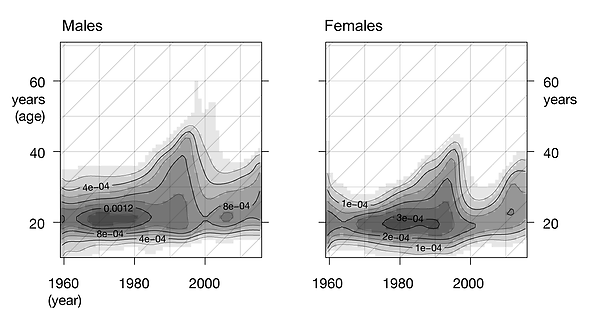
The all-cause hump is centered on age 20. It is not of constant shape, showing a peak in the 1970s (males) and 1980s (females). The male hump is higher and wider than that of females. This goes together well with the notion that males behave more risky at teenage ages than females.
The hump is getting wider and wider even into the 30s and 40s, until approximately 1997 when it suddenly drops off strongly, due in large part to the introduction of antretrovirals in the fight against HIV/AIDS, but also other causes. Much of this widening through the 80s and 90s was due to the excess mortality of the cohorts of the 1950s, which have carried a stronger signature of external mortality from their youth through adulthood. Since the year 2000 the hump has started widening again, largely due to poisonings.
The onset of the hump is relatively stable between 10 and 15 years of age. This could express a sort of turmoil inherent to adolescence, as often discussed in the psychological literature. As recent studies show the adolescent brain seems to develop in a way that generates a mismatch between being able to anticipate and regulate emotions. As a consequence, adolescents more often do dangerous things, encouraged by their peers. "But adolescent development is not sufficient to describe the observed patterns; historical and generational effects highlight the crucial role of socioeconomic environment on young adult vulnerability,” adds study author Adrien Remund.
The peculiarities of the all-cause hump owe to contributions from different causes of death, each of which has a unique pattern. The main ones identified by the authors are traffic accidents, poisonings, homicides, HIV-AIDS, and suicides.
Traffic accidents
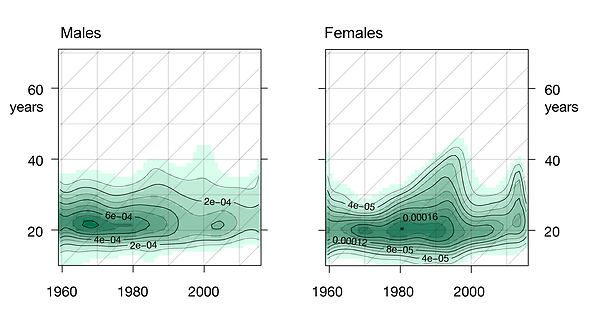
In fact, the accident hump for US males is less and less caused by traffic accidents. These have been progressively outweighed by suicides, homicides, and poisonings. For females traffic accidents remain the major contributor to the hump, with momentary increases from homicides, other accidents, and more recently from a new wave of poisonings.
Poisoning
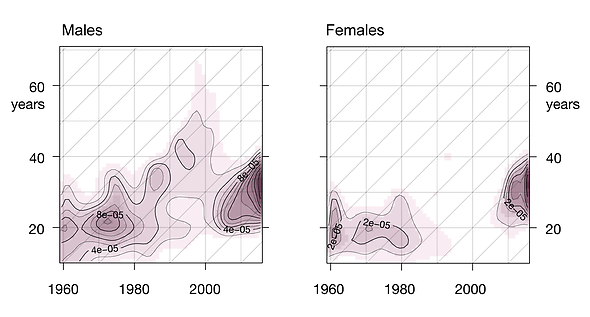
Poisoning is one of the most striking developments within the hump causes of death. Although there have been contributions from poisoning before the year 2000, its contribution to the hump has increased substantially in recent years and constitutes a new phenomenon.
Poisoning is mostly overdoses, and it includes alcohol poisoning. “The expansion of this cause in the hump in recent years is picking up on both prescription drug and heroin epidemics we think,” says MPIDR demographer Tim Riffe. “It reflects the health crisis, mainly due to a sharp increase in opioid overdoses, that has attracted quite some scientific and political attention.”
Homicides
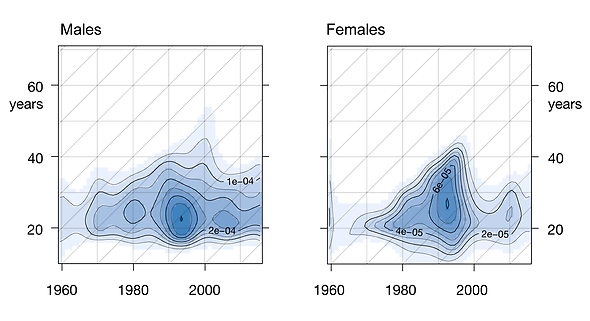
Homicide contributions to the hump show period patterns (ups and downs in the course of calendar years) both for males and females. The effects have decreased for both sexes since the 1990s but remain stronger for males.
The causes for the wave violence in the 1990s are unclear. Explanations discussed from the literature include changes in social support and economic inequalities, changes in size and strategy of police forces, and changes in crack-cocaine markets.
HIV-AIDS
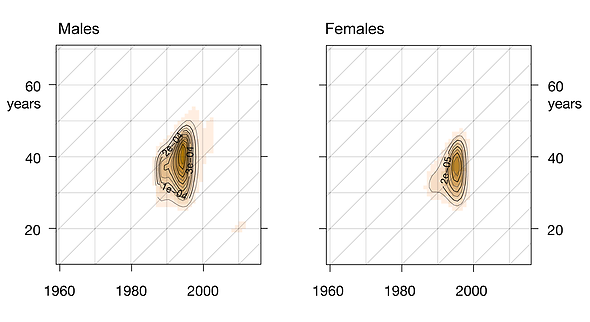
The strongest period effects stem from the HIV-AIDS epidemic. It appeared in the data in 1987 when statistics (more specifically ICD codes) began capturing the disease and then intensified quickly while at the same time, in effect pulling the hump into ages beyond 40.It suddenly diminished in 1996 when antiretroviral therapies where introduced, which postponed the age at death beyond the hump.
Suicides
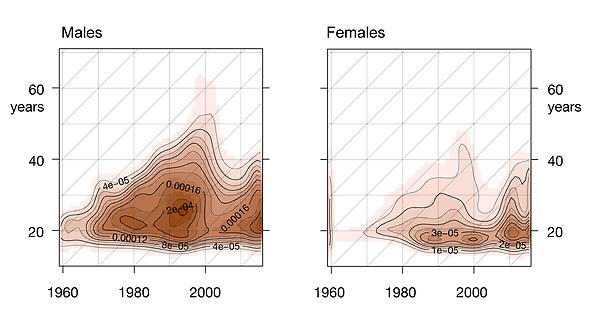
Suicides contribute much more to the male hump than to the female hump, and for both males and females the cohorts of the 1950s have carried a heavier burden of suicide that largely accounts for the odd diagonal articulation of the hump into the early 2000s. Suicides covary quite strongly with poisonings, and these have also experienced a recent increase for both males and females.
“Overall, the application of our decomposition method to U.S. data reveals mortality patterns that otherwise remain partially hidden from view and analysis,” says demographer Tim Riffe. “We hope that better measurement will increase understanding of mortality in young adult ages, and how other changes during young adulthood effect the risk of dying.”
More information
Original publication: Adrien Remund, Carlo G. Camarda, and Tim Riffe: A cause-of-death decomposition of young adult excess mortality, Demography, DOI 10.1007/s13524-018-0680-9.